L.E. Carmichael's Blog, page 2
June 27, 2025
Jennifer Harris: The Witching Hour
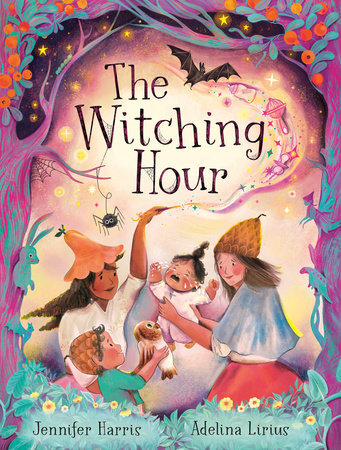 Welcome to Cantastic Authorpalooza, featuring posts by and about great Canadian children’s book creators! Today’s guest:
Jennifer Harris
. Take it away, Jennifer!
Welcome to Cantastic Authorpalooza, featuring posts by and about great Canadian children’s book creators! Today’s guest:
Jennifer Harris
. Take it away, Jennifer!
I woke up with two lines in my head:
In the witching hour,
The sky turns orange.
Just those two lines—but I knew it was something good. The language flowed in a way I liked, and the orange sky forecast there would be drama. Within five minutes I’d expanded on these two lines (breaking them up with another) and completed the opening page of The Witching Hour.
Writing isn’t supposed to be like this, I know. There’s sweat! There’s toil! But sometimes there’s a line, and that line is a mood, and so you write the mood. And anyone who’s lived through that time after dusk with a fussy baby or toddler—known colloquially as the witching hour—fully understands the exhaustion and humour of turning yourself inside out to try and calm them. That’s definitely A MOOD.
In this story there’s a twist: the family are witches. It may have been the vibrant autumn orange I pictured in my head that made this seem like an organic choice. It certainly wasn’t a “eureka” moment (I hadn’t even had coffee yet). The witches would seem to have an advantage over the rest of us: they don’t just have bouncing and milk available to them to calm a cranky child—they have brooms and magic! Does magic help? OF COURSE NOT! Because as anyone who’s lived through this phase knows, nothing helps, or if it does, what worked yesterday probably won’t work tomorrow. So you just keep trying increasingly ridiculous things. Here, that contributes to the dramatic tension and the escalation of humour. Child readers will be entertained and amused by the magical tricks the witches try; parents will laugh, probably because it’s funny, but possibly also because it’s very relatable.
Aside from a cranky baby and increasingly exhausted parents, I had no idea how this would be illustrated. So imagine when I opened the initial colour sketches and saw my orange suffusing the page, balanced with purple and green. It’s unlike any other palette on my picture book shelf. Tundra editor Sam Swenson conjured the perfect illustrator, Adelina Lirius, who worked her own magic. These are not the warty hunched witches of Halloween décor; they’re soft forest witches who look like they were born from wood lilies and honeysuckle. And the baby’s face—it’s so hard not to laugh, because the expressions of doubt, distress, and dismay are all-too familiar. (Is this the time to say one of my children didn’t sleep through the night until age two? After a decade, we’ve almost recovered.) The cats are doing what cats do in the most delightful way, and the spiders and mice are fun to track through the pages.
To be honest, by the time I’d finished writing The Witching Hour, I wasn’t sure what I had. It felt like an oddball—a lyrical and slyly funny manuscript. But would editors see it as a picture book? Now, looking it brought to life with illustrations, it’s quite clear it’s a picture book, and I’m grateful Sam Swenson saw it that way from the beginning. It’s a Halloween book, a new baby book, a sibling book, and a funny look-at-that-cat book (which should be a category, if it isn’t). My hope is it finds a readership who appreciate it for itself, inviting it to birthday parties and baby showers and sleepovers, and making it feel welcome in the world.
June 14, 2025
Oksanna Crawley: How a Reader Becomes a Writer
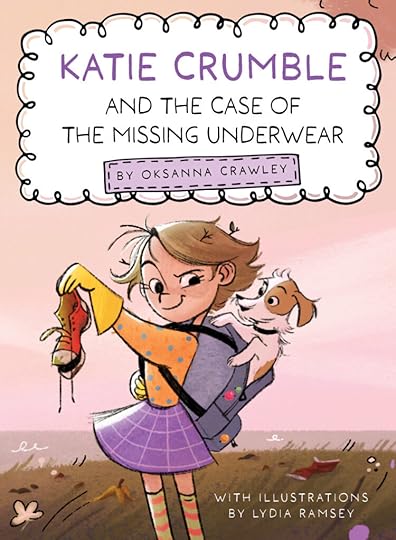 Welcome to Cantastic Authorpalooza, featuring posts by and about great Canadian children’s book creators! Today’s guest:
Oksanna Crawley
. Take it away, Oksanna!
Welcome to Cantastic Authorpalooza, featuring posts by and about great Canadian children’s book creators! Today’s guest:
Oksanna Crawley
. Take it away, Oksanna!
My earliest memories of books take me back to my hometown of Val d’Or, Quebec, lying in bed, reading Winnie the Pooh. In Toronto, when I was a bit older, I saved up my money (50 cents!), walked to the store and picked up the latest Peanuts paperback with my favourite, Snoopy. The adorable beagle was one of the first things I remember drawing over and over again. He became mine somehow. A love of creative writing was born when I was in grade 4. My class broke out in cheers and applause after I read my scary Hallowe’en story out loud. That was it! All the way through high school, I enjoyed writing stories and poetry. The poetry was an outlet for the intense emotions teenagers tend to feel.
An 8-year career in radio broadcasting helped me to hone my writing skills. The writing had to be fast, brief and accurate. During my teaching career I must have read thousands of picture books to my students. With their beautiful words and art, they are the jewels of the publishing world. The desire to write one myself never went away. Once I retired, I started to take writing and art courses.
When I got my first publishing contract, it was better than winning the lottery! Pure joy! My latest is a chapter book, Katie Crumble and the Case of the Missing Underwear. I love to make children laugh and I hope this one does. It’s a great way to motivate kids to read, and write stories! Katie is a quirky, stubborn little girl with a wild imagination who loves to solve mysteries with her sweet dog, Aggie McDoogall. I began to write it in a writing class given by Brian Henry. The original protagonist was a smoking dog detective. Funny, I thought, but not a good role model for kids! The story was years in the making. Proof that perseverance is one of the most important traits for a writer. Keep learning and keep writing and revising! I learned to take rejection from publishers and the few words of encouragement I was lucky to get, kept me going. Don’t give up! A second Katie Crumble story is already in the works!
To learn more about Oksanna and her books, visit her website.
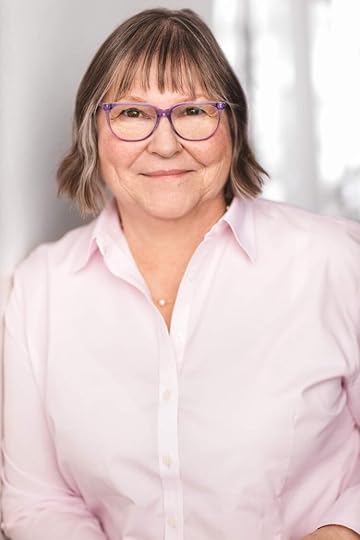
Katie Crumble and the Case of the Missing Underpants
Written by Oksanna Crawley & Illustrated by Lydia Ramsey
Published by Plumleaf Press, May 1, 2025
Ages: 6 to 9
ISBN: 9781738165285
June 8, 2025
World Ocean Day: Resources for Educators

Whale watching expedition in Nova Scotia. We were lucky enough to spot a mother humpback whale and her calf!
Happy World Ocean Day! For the educators in the room, here are some resources that will help make it a great one:
The official World Ocean Day website is a great place to start.
Make sure to check out their resource page!
Rochelle Strauss, children’s author and ocean fanatic, has written some great science books for ocean-loving kids.
Helaine Becker’s The Big Green Book of the Big Blue Sea is an incredible hands-on resource for kids.
Want more? I got you.
Did you know that I offer an elementary science program called Ocean Migrations? Here’s the description:
What do humpback whales, northern wolves and arctic foxes have in common? Their life cycles all include migration. In this deep dive into animal migration, we’ll define three different types of migration, and meet Arctic animals that use each type. Whether over the ice or under the sea, each migration depends upon the world’s oceans. We’ll finish by discussing potential impacts of global climate change on wildlife migration. Drawing on my PhD research and my book Polar: Wildlife at the Ends of the Earth, this presentation is the perfect ending to any elementary science migration unit.
Granted, it’s a little late to schedule a school visit for… today. But I’m taking bookings for the 2025/26 school year, and I would love to visit your classroom or library, either virtually or on site! Contact me to schedule.
And in the meantime, share your ocean love and ocean action with the official hashtags:
#WorldOceansDay
#BigBlueFuture
May 11, 2025
Flap, Little Birdies, Flap Flap!
I collect information the way crows collect shiny things! Historically, this impulse to collect the weird and wonderful found expression in cabinets of curiosities: precursors of modern museums assembled by aristocrats, explorers, and early scientists. While I acknowledge the devastating context of colonialism* in which these cabinets were assembled, I share the deep sense of awe and wonder that motivated their creators. And so:
Welcome to my own cabinet of curiosities—facts, quotes, and oddments about pretty much everything!
For today’s edition, some fun facts in celebration of World Migratory Bird Day!
The science word for a bird’s “wishbone” is “furcula.” It’s basically two collarbones fused together, and it’s got a very important function. When a flying bird brings its wings down, the furcula compresses, storing some of force of the flap. When the furcula springs back into shape, it releases that stored force, helping to push the bird’s wings back up. All of which saves energy when going flap, flap, flap over long distances during migration!
Want more? Check out my book The Boreal Forest, which features several migratory birds that nest in or pass through this important biome.

#WorldMigratoryBirdDay
#WMBD2025
* For more info on historical cabinets of curiosities, check out these articles:
Smithsonian Mag: How Cabinets of Curiosities Laid the Foundation for Modern Museums
Sotheby’s Institute of Art: Cabinets of Curiosities and the Origin of Collecting
Art & Object: The Cabinet of Curiosities & Colonialism
https://www.artandobject.com/news/cabinet-curiosities-colonialism
May 3, 2025
Erin Alladin: Don’t Disconnect. Reconnect.
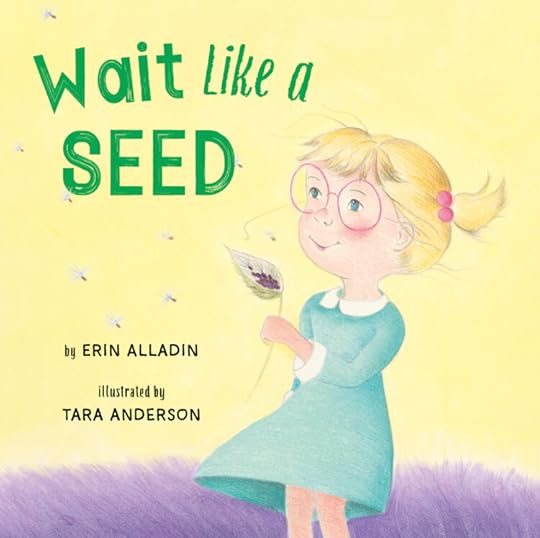 Welcome to Cantastic Authorpalooza, featuring posts by and about great Canadian children’s book creators! Today’s guest:
Erin Alladin
. Take it away, Erin!
Welcome to Cantastic Authorpalooza, featuring posts by and about great Canadian children’s book creators! Today’s guest:
Erin Alladin
. Take it away, Erin!
In our hyper-online world, we worry about the effect our devices are having on us—and especially on our children. We strategize ways to disconnect from social media, from apps, from the dopamine machines we carry around in our pockets.
But what if we’re looking at it backward?
What if we’re trying to treat a symptom instead of the problem?
Human beings need connection: with each other, with nature, with the place we come from. We’re innate storytellers, and our stories weave webs of connection between our experiences and the world around us.
When I started writing my newest picture book, Wait Like a Seed, I didn’t realize that was what I was doing. I set out to recreate the “seed stretches” exercise I do with kids in school visits to transition from energetic action songs to quiet attentiveness. We curl our bodies like seeds, stretch out a foot like a root, reach up like shoots, and open our arms like leaves, moving physically through the cycle while I describe the natural triggers for each change. In the manuscript, the words flowed into second person:
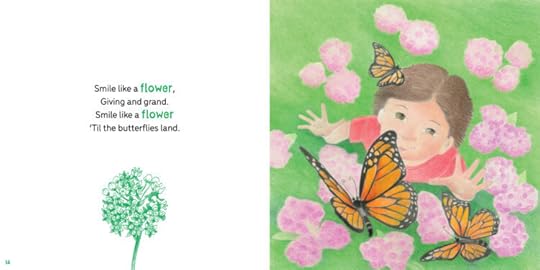 Wait like a seed, / Cozy and small. / Wait like a seed / ‘Til the spring rains fall.
Wait like a seed, / Cozy and small. / Wait like a seed / ‘Til the spring rains fall.
Suddenly, it wasn’t just about a handy cool-down exercise that doubles as a science lesson. I wanted kids to be drawn into the magic of the seed’s life cycle, and to sense the parallels with their own lives:
Hope like a bud, / Eager to start. / Hope like a bud / ‘Til your petals part.
When the manuscript was accepted and ready for illustrations, the publisher and I talked about what plant should be featured. We agreed on milkweed, which is the sole larval host plant for the endangered monarch butterfly. I love this choice, because kids can so easily build a relationship with milkweed…and therefore with monarchs. There are native varieties of the plant all over North America, and families can grow it in the ground or in pots, find it in pollinator gardens or waste spaces, and encourage their municipalities to protect it. If they find monarch caterpillars in a precarious situation, they can raise them at home and release them as adult butterflies. Suddenly, nature and humanity are no longer two solitudes at odds with each other. They are one whole made up of intersecting cycles.
That’s empowerment. That’s connection. That’s rootedness.
I grew up monitoring monarch caterpillars and sipping the nectar from clovers and learning the names of the trees and wildflowers around me. They gave me kinship, and a connection with other people who cared about them. I want the same for kids today, and for their grown-ups. If we connect enough with the natural world, it isn’t such a struggle to disconnect from the digital one.
How to use this book: ParentsRead the poetry together. Act out each page: curl up like a seed, spread one leg out like a root, reach up like a sprout, open your arms as leaves…Look at the information at the back about milkweeds and monarchs. Brainstorm places milkweed might grow in your area. This summer, take walks to look for it and check for monarch caterpillars.Watch germination in real time by placing a large seed (beans and peas work well) between the edge of a clear cup and a paper towel that contains a scoop of moist soil.Plant a butterfly garden. In addition to milkweed, grow many flowering native plants so that something is always in bloom from early spring to late fall. Plant them close together in a sunny location with wind protection. Include a water source and a brush pile or shrubs where pupae can be sheltered. In an apartment or condo, grow your plants in large pots and marvel at how many insects find your balcony.How to use this book: TeachersWait Like a Seed contains nine full-colour pages of informative back matter covering:
The life cycle of a milkweed plant (eight illustrations)The life cycle of monarch butterflies (eight illustrations)Facts about monarchs and milkweedInformation about the monarch’s remarkable migration cycleA glossarySelected readingsMore resources about monarchs and milkweedThis book connects to multiple curriculum topics, including:
The needs of living thingsThe life cycle of a butterflyThe life cycle of a plantPair a reading of Wait Like a Seed with:
A lesson on life cyclesA seed-sowing activityA research project on butterflies and their habitat needsA lesson on the anatomy of a rhymeA shared writing activity in which you collectively write your own version for another natural cycle: Fall like the rain, Hatch like an egg, etc.You can learn more about Erin and her books by visiting her website.
April 22, 2025
Rochelle Strauss: Why Hope Matters
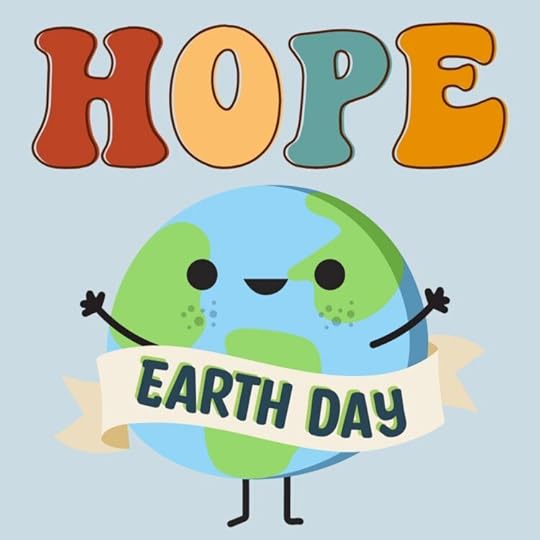 As we celebrate Earth Day this year, amidst much turmoil and uncertainty, there is one word that that I want you to hold on to – hope. Yes, you heard me right. HOPE!
As we celebrate Earth Day this year, amidst much turmoil and uncertainty, there is one word that that I want you to hold on to – hope. Yes, you heard me right. HOPE!
Every year on Earth Day, we are presented with the litany of challenges facing the planet – from climate change and warming temperatures, to rising sea levels and shrinking forests. Let that sink in for a moment. We “celebrate” Earth Day by sharing stories of loss and catastrophe.
Don’t get me wrong – we absolutely need to build awareness about what is happening to the planet, but the barrage of horror stories, amidst a world of growing horror, can feel overwhelming. The stories are hard enough to process as an adult but imagine being eight years old and hearing story after story about the coral reefs dying, or Sumatran orangutans losing their homes, or perhaps more locally for some, stories of extreme droughts, fires and storms.
For a child, that’s not just scary, it’s overwhelming. And frankly, it can feel that way as an adult too.
But here’s the thing – doom and gloom doesn’t inspire action. HOPE does.
Jane Goodall has said that hope is what enables us to keep going in the face of adversity. Hope is not passive. Hope is active. Hope is a verb.
As a children’s author and educator, I’ve spent years exploring how stories can plant seeds — not just of knowledge, but of curiosity, courage, and care. And if there’s one thing I’ve learned, it’s this: when it comes to the environment, kids don’t need to be scared into action. They need to be inspired. They need to feel HOPE.
With this focus on hope driving much of my current research and storytelling, I’ve chosen to celebrate this Earth Day by emphasizing hope – and I encourage you to, as well. For me, hope comes from stories of action and engagement, as well as from stories of out of the box thinking and innovation. Hope also comes from books – reading stories that both raise awareness of the issues and offer opportunities and ideas for dialogue, engagement and action.
My challenge to you this Earth Day is to find and share stories of HOPE. And to use these stories to inspire your own actions and commitments.

Photo Credit: Rochelle Strauss, 2022
Here are just a few stories to get you started on your path of hope.
Community Action and Engagement: Keep Collingwood Clean is a powerhouse group of volunteers in Collingwood, Canada who have turned trash into a passion project. Whether they’re picking up litter from streets, trails, or the shoreline, they’re doing far more than just tidying up. Their hard work is keeping garbage out of sewers and protecting Collingwood’s harbour. They even tackle the tiny stuff—like cigarette butts, which are made of plastic. Thanks to their efforts, local businesses have installed cigarette collection cans to help keep the butts off the street. And the collected butts? They are sent to TerraCycle, where the tobacco and ash are composted, and the plastic is recycled into raw materials. Cleaner streets, cleaner water, and a whole lot of community spirit!Using Science to Combat Microplastics: Back in 2019, Irish teen Fionn Ferreira made a big splash at the Google Science Fair with an idea for removing microplastic from water. In his experiment, Fionn combined microplastics with ferrofluid (a magnetic liquid) and discovered that he could use magnets to pull the plastics right out of the water. This simple, but clever idea is full of possibility. Now he’s exploring how his idea can be scaled up to address microplastics in wastewater at water treatment plants. A brilliant reminder that BIG solutions start with small experiments and curious minds!
Hashtag: No Waste: Every year, the National Geographic Slingshot Challenge invites young changemakers to share their bold ideas for solving environmental problems. In 2024, Kayla Ling stepped up with No Waste Nation, a project designed to bring waste reducers together through the power of social media. Her Instagram account (@no.waste.nation) showcases how cutting back on waste can be accessible, engaging, and yes, even fun! Through her posts Kayla highlights everyday ways to reduce consumption and eliminate waste. Her idea was among the winners of the 2023 Slingshot Challenge, and she recently made history as the first ever recipient of the Sustainable San Mateo County Youth Sustainability Award. Kayla’s work is a reminder that youth voices can lead the way to a cleaner and greener future!
Want more?
This year’s Earth Day theme is Our Power, Our Planet. Be sure to check out Earthday.org for more information about Earth Day actions and events near you! And if you are sharing your actions on social media, please use the hashtag #EarthActionDay and tag me on IG @rochellestraussauthor or BlueSky: @rochellestrauss.bsky.social
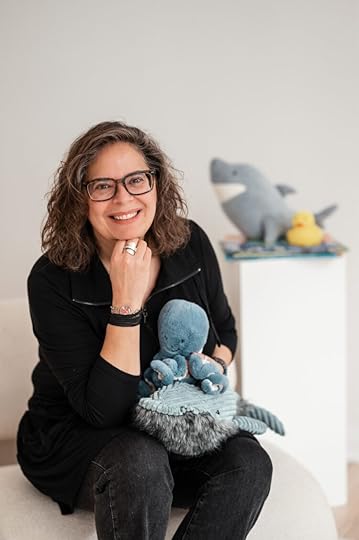 About Rochelle
About Rochelle
Rochelle Strauss is on a mission to change the world – one book at a time! As an environmental educator and award-winning children’s author, Rochelle is dedicated to building environmental literacy and inspiring people to become active stewards of our planet. Through her work, she uses compelling storytelling to bring complex environmental issues to life, helping young people better understand the natural world and empowering them to make a positive impact. Rochelle’s children’s books have won several awards, been translated globally and incorporated into curriculum in the US. The Global Ocean is a UNESCO endorsed Ocean Decade Activity, and One Well: The Story of Water on Earth was selected as part of the UN’s SDG Book Club in support of SDG 6 – Clean Water and Sanitation. One Well has also sold over half a million copies internationally. Rochelle has two new books about water arriving in 2026 and 2027.
April 11, 2025
Why I Write for Children
“So when are you going to write a real book?”
Any children’s writers reading this are groaning right now, because this is a question we’ve all been asked at least once. Most of us respond with comically-exaggerated confusion and, “As opposed to all of the imaginary ones?”
Meanwhile, we’re drowning in despair, because what the questioner means is, “When are you going to write a book for adults?” As if books for kids are in some way less. Less artistic, or less interesting, and certainly less important.
I argue, however, that books for kids are actually MORE important than books for adults.
Exhibit A – this article from The National Post:
People with Extreme Anti-Science Views Know the Least, But Think They Know the Most: Study
TL;DR is that people—meaning adults—are terrible judges of the extent and accuracy of our own knowledge. Those of us who know the least about a topic believe we know the most… making us the most resistant to new information and ideas.
Kids (and most teenagers) don’t have this problem. Kids are completely aware of the fact that they don’t know everything – and what’s more, they’re hungry to learn. Even kids who claim they don’t like school are voracious consumers of data on the subjects they actually care about. And if you show kids why a topic is interesting or relevant to their lives, you can get them fired up to learn about just about anything.
Exhibit B—the grade 7s & 8s at a school where I presented recently. Middle schoolers have a bad rap for being the hardest to reach, but we had a fabulous discussion about forensic science, during which these teenagers not only paid rapt attention, but asked questions that proved they were integrating the info I was giving them with things they already knew. Several students thanked me for the cool presentation, and a couple even told me that they want to be scientists when they grow up.
These are the kinds of impacts that only children’s writers get to have – more than any other kind of writer, children’s writers have the power and privilege of validating people’s interests and opening their minds to new ideas.
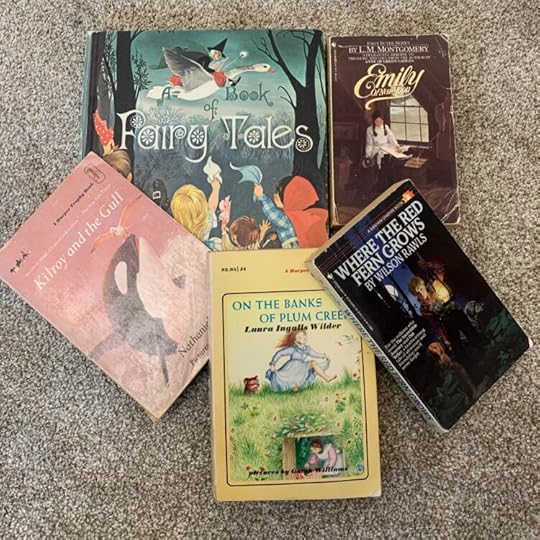 For many writers, this is why children’s books are the only “real” books. For me, there’s an additional reason:
For many writers, this is why children’s books are the only “real” books. For me, there’s an additional reason:
Pop quiz: Out of the books you read last year, which was your favourite?
If you don’t remember, don’t worry—I don’t remember, either! These days, it’s had enough to remember what I read last year, much less what I thought about it (which is why I track my reading on StoryGraph).
Let’s try this one: What was your favourite book when you were a kid?
Mine included:
Fairy tale collections
Where the Red Fern Grows, which I read over and over again, despite starting to sob ten pages in advance of the terrible thing that happens at the end…
Unlike the reading we do as adults, the books we read as children shape who we are and stay with us forever. I dream of the day an adult will tell me that one of my books was their favourite as a child. And I do my very best to ensure that my work is worthy of the privilege.
April 5, 2025
Jennifer Maruno Introduces Chidori
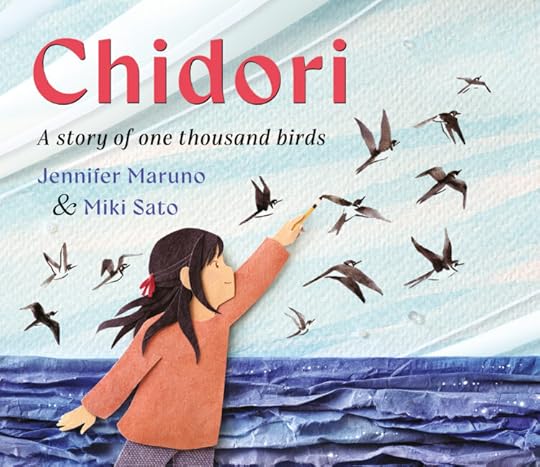 Welcome to Cantastic Authorpalooza, featuring posts by and about great Canadian children’s book creators! Today’s guest:
Jennifer Maruno
. Take it away, Jennifer!
Welcome to Cantastic Authorpalooza, featuring posts by and about great Canadian children’s book creators! Today’s guest:
Jennifer Maruno
. Take it away, Jennifer!
Chidori is the story of the 2011 Japanese earthquake and tsunami, told from the point of view of a young girl who must wait with her class on the roof of her school, watching the monster tide consume everything in its wake.
Why did I write this book? Natural disasters are becoming more common as the climate of our Earth changes. Many children in North America have not experienced the devastation of an earthquake or tsunami first hand. I was hoping to create empathy for those who do suffer natural disasters.
The starting point for peace is understanding someone else’s pain. Feeling pain is what makes us human and develops into empathy. Having empathy means you are able to share other people’s feelings and respond with compassion. Empathy is a key ingredient in learning to be generous and less retaliative. People who are empathetic demonstrate less bias and systematic racism.
Hana’s mother is washed away. At first, she denies her loss. She accepts it when her father arrives with her grandmother instead. There will always be rest after nature’s wrath, but it is recovery that takes time. Grief doesn’t actually get smaller. Life around gets larger with new beginnings and new experiences. Hana’s new experience was learning to paint like her mother.

Eiko Kitagawa Maruno, Sumi-e artist
Many people find solace in art. Sumi means ink,-e means picture. It is a contemplative art which expresses the essence of a subject, keeping with the Japanese Zen philosophy. Sumi-e only uses ink and space to create balance and harmony that is pleasing to the eye, mind and soul. Hana chose to honour her mother in a unique way by painting the shore birds that her mother loved. She painted them ascending the hill to the rock where they used to meet after school.
I have a very personal connection to Chidori. My mother-in-law Eiko Kitagawa Maruno is an honoured member of the Sumi-e Artists of Canada. Eiko took painting lessons as late as her 85th year. Each level that she achieved, she was rewarded with a stamp. The sumi-e stamp is used like a signature. Stamps are awarded by a teacher after a student has achieved a particular level of expertise. Eiko was awarded several stamps. She often signed her name below her stamp to honour her Canadian birth and heritage.
Many of her beautiful works hang in our house, always evoking wonderful memories of her life and the losses she had to overcome during the Japanese internment of WW2.
I was thrilled to have Miki Sato illustrate the manuscript. She brought amazing energy, texture and solace to the pages. I hope after reading this book children and adults will attempt this ancient art of brush painting.

Brush painting by Eiko Kitakawa Maruno
March 21, 2025
The Great Big Boreal Forest Resource List
Happy International Day of Forests! You may know that I wrote a children’s science book about The Boreal Forest, but did you know that I’d compiled this list of free resources to use along with it? Great stuff for educators, parents, and forest enthusiasts of all stripes.
And did I mention it’s all free?
The Great Big Boreal Forest Resource ListFirst – it’s a video of me reading from the book!Here’s a sneak peak of the foresty goodness contained in this book. May it bring the outdoors inside to you.
 The Official Boreal Forest Activity Guides
The Official Boreal Forest Activity GuidesClick here to download the official teacher’s guide for The Boreal Forest.
Click here for a BONUS free activity guide. This one includes suggestions for science, social studies, and language arts, and will help support a variety of elementary school curriculum outcomes. Not to mention a little creativity and fun.
But why stop there?
Natural Resources Canada: Boreal Forest Pages
NASA Earth Observatory: The Carbon Cycle – A detailed overview of the global carbon cycle, in which the boreal forest plays a crucial role
NASA Precipitation Education: The Water Cycle – A kid-friendly resource that includes activities and lesson plans
IUCN Red List of Threatened Species – Find the conservation status of your favourite boreal plants and animals
The Cornell Lab of Ornithology: Birds of the World – This is a superb resource, but note that it does require a paid subscription
Keeping the Carbon in Alaska Forests
A photographer who discovered baby bears dancing in a forest thought he was imagining it
Bird that looks like it died yesterday turns out to be 46,000 years old
How deforestation drives the emergence of novel coronaviruses
What do wild animals do in a wildfire?
Totally bizarre facts about the star-nosed mole
Lesson Plans, Activities, ProjectsCanadian Wildlife Federation: Boost the Boreal Forest
Boreal Songbird Initiative: Provincial and Territorial Forest Facts
Nature Canada: For Children Section – Articles and a Resource Section
Forests Ontario: Community Engagement Section
NASA Precipitation Education: The Water Cycle
Utah State University: Water Cycle Lesson Plans
California Academy of Sciences: Carbon Cycle Role Play
University of Colorado Teach Engineering: Carbon Cycles
 Indigenous Peoples of the Boreal Forest
Indigenous Peoples of the Boreal ForestNote:
Worldwide, hundreds of Indigenous peoples live in the boreal biome. I’ve included resources for those peoples featured in my book, but I encourage you to learn about the Nations nearest you!
Canada
Gwich’in Social & Cultural Institute – a repository of Traditional Knowledge, including audio recordings of Gwich’in words and information on Gwich’in medicine plants
The Whitefeather Forest Initiative of the Pikangikum First Nation – general info and links to research involving Traditional Knowledge
Europe/Asia
Reindeer Herding – information on reindeer (caribou) and the many Indigenous peoples of Europe and Asia who herd them
Association of Indigenous Peoples of the North, Siberia, and the Far East of the Russian Federation – This site is in Russian, but Google translate will give you a starting point for further research
Organizations
Ontario Nature – Boreal Forests Section
The PEW Charitable Trusts: International Boreal Conservation Campaign
Science Books for Adults
For teenagers that want to learn more, or for adults who want more knowledge to help support their children’s learning – here are some of the adult-level books I consulted while researching The Boreal Forest. Check your local library for ebook options, or see what you can find online!
Bannick, Paul (2008) The Owl and the Woodpecker: Encounters with North America’s Most Iconic Birds. Seattle, WA: The Mountaineers Books.
Bondrup-Nielsen, Soren (2009) A Sound Like Water Dripping: In Search of the Boreal Owl. Kentville, NS: Gaspereau Press.
Chang, Mingteh (2013) Forest Hydrology: An Introduction to Water and Forests. Boca Raton, FL: CRC Press.
Crawford, R.M.M. (2013) Tundra-Taiga Biology: Human, Plant, and Animal Survival in the Arctic. Oxford: Oxford University Press.
Gawthrop, Daniel (1999) Vanishing Halo: Saving the Boreal Forest. Vancouver, BC: Greystone Books.
Lynch, Wayne. (2001) The Great Northern Kingdom: Life in the Boreal Forest. Markham, ON: Fitzhenry & Whiteside.
Do you know of additional boreal resources? Drop them in the comments for others to explore!
March 14, 2025
Thanks for the Polar Love!
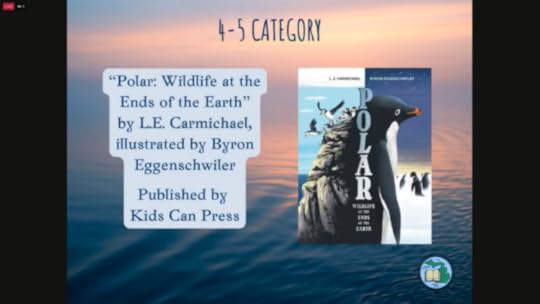 Two quick news nuggets to share:
Two quick news nuggets to share:
Thank you to Helen Kubiw at CanLit for LittleCanadians, who interviewed me and Byron Eggenschwiler after our book, Polar: Wildlife at the Ends of the Earth, won the Lane Anderson Award for best Canadian science book for young readers.
And thank you to the Michigan Reading Association for nominating Polar for the Great Lakes Great Books Award. Kids in grades 4 and 5 will read the 2025-26 nominees and vote for their favourites. Polar is part of a truly stellar group, and I could not be more delighted!



